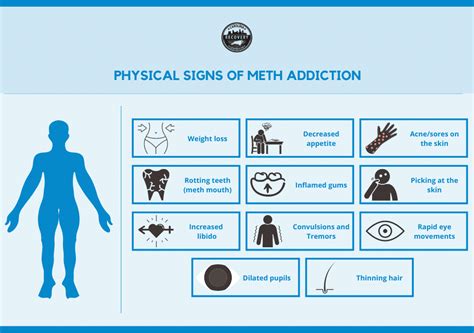Intro
Discover the dangers of methamphetamine, a highly addictive stimulant. Learn about meth effects, addiction signs, and recovery options for this potent substance.
Methamphetamine, commonly referred to as meth, is a potent and highly addictive synthetic stimulant that affects the central nervous system. It is known for its long-lasting effects, which can include increased energy, alertness, and a sense of euphoria. However, methamphetamine use is also associated with a range of serious health risks, including cardiovascular problems, neurological damage, and severe dental and skin issues. The drug's addictive nature and the potential for severe health consequences have made it a significant public health concern worldwide.
The history of methamphetamine dates back to the early 20th century, when it was first synthesized in Japan. Initially, it was used for medical purposes, including the treatment of narcolepsy, attention deficit hyperactivity disorder (ADHD), and obesity. However, its potential for abuse soon became apparent, and by the mid-20th century, many countries had restricted its use due to concerns over its safety and addictive potential. Despite these efforts, methamphetamine has continued to be produced and used illicitly, with its popularity varying by region and over time.
One of the reasons methamphetamine remains a significant public health issue is its widespread availability and ease of production. Unlike many other illicit drugs, which require specific plants or complex chemical processes to produce, methamphetamine can be synthesized from a variety of readily available precursors. This has made it possible for small-scale, clandestine labs to produce the drug, contributing to its widespread availability and the difficulty in controlling its distribution.
Understanding Methamphetamine

Understanding the chemical and pharmacological properties of methamphetamine is crucial for appreciating its effects on the body and mind. Methamphetamine is a member of the amphetamine family of substances, which are known for their stimulant effects. When ingested, methamphetamine increases the levels of certain neurotransmitters in the brain, such as dopamine, norepinephrine, and serotonin, leading to its stimulant and euphoric effects. However, this alteration in brain chemistry also underlies the drug's potential for addiction and its capacity to cause long-term neurological damage.
Pharmacology of Methamphetamine
The pharmacology of methamphetamine involves its absorption, distribution, metabolism, and excretion in the body. Methamphetamine can be administered through various routes, including oral ingestion, smoking, injection, and snorting. The drug's effects are rapid, regardless of the method of administration, due to its high lipophilicity, which allows it to cross the blood-brain barrier quickly. The half-life of methamphetamine, which is the time it takes for the concentration of the drug in the bloodstream to reduce by half, varies but is generally longer than that of other amphetamines, contributing to its prolonged effects.Methamphetamine Use and Abuse

Methamphetamine use and abuse are characterized by a pattern of compulsive seeking and use of the drug despite knowledge of its harmful effects. The drug's addictive potential is extremely high, with users often quickly escalating from occasional use to daily or near-daily use. Methamphetamine abuse can lead to significant social, occupational, and interpersonal problems, as well as serious health issues. Users may experience severe weight loss, skin sores, poor oral health, and increased risk of infectious diseases like HIV and hepatitis due to shared needle use.
Risks and Consequences
The risks and consequences of methamphetamine use are multifaceted and can be devastating. Cardiovascular issues, including heart attacks, strokes, and arrhythmias, are among the most serious health risks. Neurological effects can range from anxiety, paranoia, and hallucinations to more severe conditions like psychosis and suicidal thoughts. The drug's impact on dental health, often referred to as "meth mouth," includes severe tooth decay, gum disease, and tooth loss, primarily due to poor oral hygiene and the drug's effects on saliva production and tooth grinding.Treatment and Recovery

Treatment and recovery from methamphetamine addiction are challenging but possible. Effective treatment typically involves a combination of behavioral therapies, such as cognitive-behavioral therapy (CBT) and contingency management, which aim to help individuals understand and change their behaviors related to drug use. Medications may also be used to manage withdrawal symptoms and cravings, although there is currently no FDA-approved medication specifically for methamphetamine addiction.
Behavioral Therapies
Behavioral therapies are the cornerstone of methamphetamine addiction treatment. These therapies focus on addressing the psychological and social factors that contribute to drug use, helping individuals to develop coping skills, and supporting them in maintaining sobriety. The Matrix Model, a comprehensive behavioral treatment approach that combines elements of CBT, family therapy, and 12-step support, has shown promise in treating methamphetamine addiction.Prevention Efforts

Prevention efforts are critical in reducing the incidence of methamphetamine use and addiction. These efforts include public education campaigns to raise awareness about the dangers of methamphetamine, community-based programs aimed at reducing risk factors for drug use, and policies to restrict the availability of precursor chemicals used in methamphetamine production. Schools and families also play a crucial role in prevention by promoting healthy behaviors, providing support, and educating children and adolescents about the risks of drug use.
Community Involvement
Community involvement is essential for effective prevention and intervention strategies. This can involve collaboration between law enforcement, healthcare providers, schools, and community organizations to identify and address the root causes of methamphetamine use in specific areas. Additionally, peer support groups and outreach programs can provide critical support to individuals struggling with addiction, helping them to access treatment and maintain recovery.Societal Impact

The societal impact of methamphetamine use is profound, affecting not only individuals who use the drug but also their families, communities, and society as a whole. The economic burden of methamphetamine addiction includes the costs of healthcare, law enforcement, and lost productivity. Furthermore, the drug's association with violent crime, domestic violence, and child neglect adds to its societal toll.
Economic Burden
The economic burden of methamphetamine addiction is substantial. Estimates suggest that the total annual cost of methamphetamine use in the United States alone is in the billions of dollars, factoring in healthcare expenditures, criminal justice system costs, and losses in productivity. This economic impact underscores the need for comprehensive and effective strategies to prevent and treat methamphetamine addiction.Future Directions

Future directions in addressing methamphetamine addiction involve continued research into the drug's effects on the brain and body, development of effective medications for treatment, and implementation of evidence-based prevention and intervention programs. There is also a growing recognition of the importance of addressing the social determinants of health and the root causes of drug use, such as poverty, trauma, and lack of access to healthcare and social services.
Research and Development
Research and development are crucial for advancing our understanding of methamphetamine addiction and improving treatment outcomes. This includes studies on the neurobiology of methamphetamine addiction, clinical trials of new medications, and evaluation of behavioral therapies. Additionally, research into the genetic and environmental factors that contribute to vulnerability to methamphetamine addiction can help in developing targeted prevention and intervention strategies.What are the signs and symptoms of methamphetamine use?
+Signs and symptoms of methamphetamine use can include increased energy and alertness, weight loss, poor oral health, and changes in behavior such as anxiety, paranoia, and hallucinations.
How is methamphetamine addiction treated?
+Methamphetamine addiction is typically treated with a combination of behavioral therapies, such as cognitive-behavioral therapy and contingency management, and sometimes medications to manage withdrawal symptoms and cravings.
What can be done to prevent methamphetamine use?
+Prevention efforts include public education campaigns, community-based programs to reduce risk factors for drug use, and policies to restrict the availability of precursor chemicals. Schools and families also play a critical role in promoting healthy behaviors and educating children about the risks of drug use.
In wrapping up this comprehensive overview of methamphetamine, it's clear that addressing this complex issue requires a multifaceted approach that includes education, prevention, treatment, and community involvement. By working together and supporting those affected by methamphetamine addiction, we can strive towards a future where the devastating consequences of this drug are minimized, and individuals and communities can thrive. We invite readers to share their thoughts, experiences, and questions regarding methamphetamine and its impact, and to consider how they can contribute to prevention and support efforts in their own communities.
